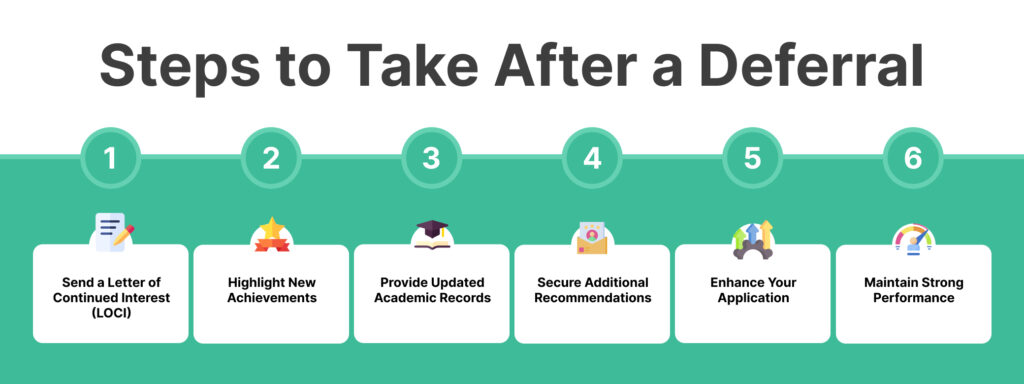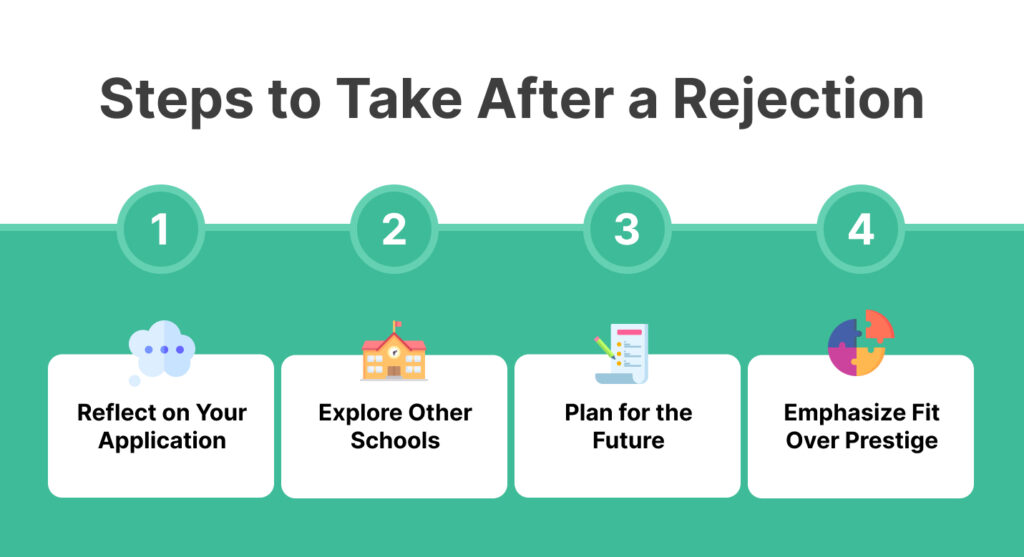- Blog
- > College Admissions
Deferred vs. Rejected in College Admissions
- Dr. Rachel Rubin
- | December 16, 2024

Navigating the college admissions process is an emotionally charged and complex process. For students, receiving an admissions decision that isn’t a clear acceptance can be particularly challenging.
Two outcomes, deferred and rejected, often leave applicants questioning their next steps and what these decisions truly mean for their future. In this comprehensive guide, we’ll explore the differences between being deferred and rejected, why these outcomes occur, and actionable strategies to respond effectively.
What Does “Deferred” Mean in College Admissions?
A deferral letter is sent when a college decides to postpone making a final decision on your application. This typically happens for early applicants who apply through Early Action or Early Decision, when colleges defer students to the regular decision pool for further consideration.
Why Do Colleges Defer Applicants?
Deferrals are not rejections. Rather, they signal that the admissions office sees potential in your application but is not ready to make an early decision. Instead, the admissions committee wants to evaluate it alongside a larger applicant pool, so they send a deferral letter. Some common reasons include:
- Competition: Early college applications may be particularly competitive, and colleges may want to reassess your application in the context of regular decision candidates.
- Additional Information Needed: Admissions officers may want to see grades from later than the first quarter of your senior year, new test scores, or further extracurricular achievements beyond what was included in your college applications.
- Demonstrated Interest: Colleges may defer students who appear less enthusiastic about attending, prioritizing applicants who have shown a clear commitment.
Being deferred offers an opportunity to strengthen your application before a final decision is made. Even if your early admissions plan did not come to fruition, deferred students are still in the running.
Steps to Take If You’re Deferred
A deferral provides a unique opportunity to advocate for yourself and strengthen your candidacy. Submitting an early application to your top picks on your college list allows more time for final decisions. Here’s what you can do:

- Send a Letter of Continued Interest (LOCI)
Crafting a Letter of Continued Interest (LOCI) is a crucial way to reaffirm your dedication to the school. Use this opportunity to reiterate why you took early action. Emphasize that the school remains your top choice and highlight specific programs, values, or opportunities that align with your goals. A well-written letter of continued interest demonstrates your enthusiasm and commitment, which can make a lasting impression on the admissions committee. - Highlight New Achievements
In your LOCI or other communications, showcase any notable accomplishments or personal growth since you first applied. Improved grades, new awards, leadership roles, or extracurricular milestones can strengthen your application by proving your continued growth and motivation. Admissions officers appreciate applicants who actively pursue excellence. - Provide Updated Academic Records
Submitting your most recent transcript to add to your initial application, especially if it reflects strong senior-year grades, can reinforce your academic consistency. This step is particularly impactful if you’ve made significant progress in challenging courses, as it demonstrates your ability to handle rigorous academic work. - Secure Additional Recommendations
A fresh letter of recommendation from a teacher, mentor, or coach can provide new perspectives on your qualifications. Choose someone who knows you well and can speak to your character, work ethic, or unique contributions, adding depth to your application. - Enhance Your Application
If applicable, consider retaking standardized tests to achieve higher scores that could boost your competitiveness. Update your resume to include any recent accomplishments, leadership roles, or community service activities. These additional materials show that you’re proactive and continuously striving for improvement even after you submit early applications. - Maintain Strong Performance
Remember, colleges often monitor applicants’ academic and extracurricular activities during the decision period, especially if you applied early. Maintain excellent grades, stay engaged in your activities, and continue to demonstrate leadership and commitment. Consistency and effort can reaffirm your readiness for college life.
By taking these proactive steps after deferral letters, you can set yourself apart from most applicants and improve your chances of securing admission during the regular decision cycle.
What Does “Rejected” Mean in College Admissions?
Rejection, by contrast, is a definitive decision that your application will not be considered for admission during that cycle. While difficult to hear, it’s important to remember that a rejection is not a reflection of your worth or potential.
Reasons for Rejection
Each university admits students it feels will fill its institutional needs, including academic performance, community involvement, and area of study.
- Limited Spots: Highly selective schools often have far more qualified applicants than available spaces, so the admission office has to make difficult decisions.
- Academic Gaps: If your grades, test scores, or coursework through senior year don’t meet the institution’s standards, this can lead to rejection.
- Application Weaknesses: Essays, recommendations, or extracurriculars that fail to stand out may impact your chances.
While a rejection is final, it’s a chance to reflect upon and re-evaluate your college plans. Fortunately, every year, many colleges offer admission to individuals who received a rejection from their first-choice college.
Steps to Take If You’re Rejected
Rejection, though disappointing, is not the end of your college journey. There are other colleges out there who would be thrilled to have you. You still have the opportunity to make an informed decision that is best for your future. Here’s how to move forward:

- Reflect on Your Application
Take time to thoughtfully analyze your application, identifying both its strengths and areas for improvement. Consider whether your essays effectively conveyed your personality, aspirations, and unique perspective. Did your extracurricular activities and achievements demonstrate meaningful impact or leadership? By understanding what worked and what could be enhanced, you can refine your approach for future opportunities. - Explore Other Schools
Shift your attention to institutions where your qualifications align more closely with their admissions criteria. Research the many schools that value your strengths and have programs tailored to your goals. Look into options with rolling admissions or extended deadlines, which can provide another chance to secure a spot at a great college. Expanding your horizons may lead to opportunities you hadn’t previously considered. - Plan for the Future
If you remain determined to attend a specific institution, consider transfer pathways. Many students successfully transfer to their top-choice school after excelling academically at another college for a year or two. Use this time to build a strong academic record, gain valuable experiences, and further prepare yourself to achieve your long-term goals. A well-executed transfer plan can bring you closer to your dream school. - Emphasize Fit Over Prestige
Remember, the name of your college doesn’t define your success—it’s more important to find a school that aligns with your personal, academic, and career aspirations. Focus on institutions where you feel supported and inspired to thrive. A college that fits you well can be the foundation for achieving your goals and leading a fulfilling life.
Remember your hard work and your value as a student. You will have a second chance to find the right school for your talents and interests.
The Emotional Impact of Deferrals and Rejections
Receiving a deferral or rejection from a college can be a challenging experience, evoking feelings of disappointment, frustration, or even self-doubt. It’s important to remember that these outcomes, while difficult, do not define your worth or potential. Approaching them with resilience and a proactive mindset can turn this moment into an opportunity for growth.
A Deferral Is an Opportunity
A deferral isn’t the end—it’s a chance to strengthen your application. Colleges are essentially asking to see more from you, whether it’s improved grades, additional achievements, or a reaffirmation of your interest. Use this time wisely to showcase your determination, growth, and suitability for the school. This process can ultimately make you a more compelling candidate.
A Rejection Opens New Doors
While a rejection may feel like a closed door, it’s also an invitation to explore schools where your talents and goals align even more closely with the mission of the school. Sometimes, a different institution may offer programs, opportunities, or a community that better supports your aspirations. Many students find themselves thriving in places they initially hadn’t considered.
Process Your Emotions and Lean on Support
Allow yourself time to process your feelings. Talk to friends, family members, or mentors who can offer perspective and encouragement. Leaning on your support system can help you regain confidence and focus on your next steps. Remember, this is just one chapter in a larger journey.
By reframing these experiences as opportunities rather than setbacks, you can move forward with clarity and determination, setting yourself up for future success.
Primary Differences Between Deferrals and Rejections
| Deferrals | Rejections | |
| Decision Status | Postponed for further review | Finalized, no further consideration |
| Likelihood of Admission | Still possible, depending on improvements | None during the current application cycle |
| Next Steps | Submit updates, show continued interest | Focus on other schools or transfer plans |
How Spark Admissions Can Help
- Crafting compelling letters of continued interest.
- Identifying opportunities to strengthen applications.
- Providing tailored advice for students exploring transfer options.
With our expertise, you can approach the admissions process with confidence, regardless of the outcome.
Moving Forward with Purpose and Determination
Even if you are deferred or rejected by one or more universities, every admissions outcome is a stepping stone on your path to success. Understanding what these decisions mean and taking proactive steps to respond can transform these challenges into opportunities. Whether you’re improving your application after a deferral or pivoting to a new plan after a rejection, staying focused and resilient will guide you toward your ultimate goals.
At Spark Admissions, we’re here to help you navigate every twist and turn of the admissions journey. Schedule a consultation today to learn how we can support your success.


